
Christian VII was King of Denmark and Norway and Duke of Schleswig and Holstein from 1766 until his death in 1808. His motto was "Gloria ex amore patriae".

Christiansborg Palace is a palace and government building on the islet of Slotsholmen in central Copenhagen, Denmark. It is the seat of the Danish Parliament, the Danish Prime Minister's Office, and the Supreme Court of Denmark. Also, several parts of the palace are used by the Danish monarch, including the Royal Reception Rooms, the Palace Chapel and the Royal Stables.
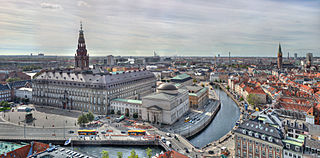
Slotsholmen is an island in the harbour of Copenhagen, Denmark, and part of Copenhagen Inner City. The name is taken from the successive castles and palaces located on the island since Bishop Absalon constructed the city's first castle on the island in 1167 at the site where Christiansborg Palace lies today.

Sophie Magdalene of Brandenburg-Kulmbach was Queen of Denmark and Norway by marriage to King Christian VI of Denmark and Norway.

Baron Herman Severin Løvenskiold was a Norwegian-born Danish composer, most noted for his score for August Bournonville's 1836 version of the ballet La Sylphide for the Royal Danish Ballet in Copenhagen.
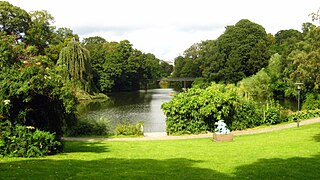
Copenhagen is a green city well endowed with open spaces. It has an extensive and well-distributed system of parks that act as venues for a wide array of events and urban life. As a supplement to the regular parks, there are a number of congenial public gardens and some cemeteries doubling as parks. It is official municipal policy in Copenhagen that all citizens by 2015 must be able to reach a park or beach on foot in less than 15 minutes.

Copenhagen Castle was a castle on the islet of Slotsholmen in central Copenhagen, Denmark. It was built in the late 14th century and was located at the site of the current Christiansborg Palace.

The Royal Library Garden, often referred to simply as the Library Garden, is a small, somewhat hidden garden between the Royal Library, the Tøjhus Museum, ChristianIV's Supply Depot and Christiansborg Palace on Slotsholmen in central Copenhagen, Denmark. It has a reputation for being one of the most tranquil spots in the city centre.

Christian IV's Arsenal, is a historic building on Slotsholmen in central Copenhagen, Denmark. It was built by Christian IV of Denmark in 1604 as part of a grand scheme for the construction of a new naval harbour. The arsenal, along with several other buildings, surrounded the harbour basin which was connected to the main harbour by a narrow canal. Later, when ships became too large to enter the harbour, the fleet moved to Bremerholm and the decommissioned naval harbour was later filled in.
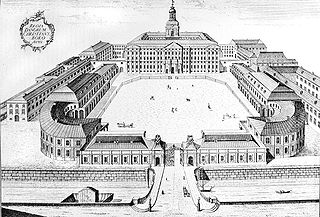
The first Christiansborg Palace in Copenhagen, Denmark, was built on Slotsholmen in 1745 as a new main residence for King Christian VI of Denmark. It was built on the same site as its predecessor, Copenhagen Castle, which had assumed a monstrous appearance and started to crumble under its own weight after several extensions.

The second Christiansborg Palace was a new main residence for the Danish Monarch built from 1803 to 1828 in Copenhagen as a replacement for the first Christiansborg Palace which had been destroyed by fire in 1794. The new palace was constructed on Slotsholmen, on the ruins of its predecessor, and designed by royal master builder Christian Frederik Hansen. By the time the palace was completed, King Frederick VI had found himself comfortable at his temporary residence at Amalienborg Palace and decided he did not want to live in the new palace after all. He only used the royal premises for entertainment. The palace also housed the Parliament and administrative services. Frederik VII was the only monarch to live in the palace. This was between 1852 and 1863.

Thorvald Jørgensen was a Danish architect, most known for his design of Christiansborg Palace, the seat of the Danish Parliament, after it had been destroyed in a fire. He has also designed a number of churches in Copenhagen. He was Royal Building Inspector from 1911 to 1938.

The Theatre Museum in the Court Theatre is situated at Christiansborg Palace on Slotsholmen, Copenhagen, Denmark, above the Royal Stables, and is on the first floor of the building. Its collection describes Danish theatre history from the 18th century to the present.

The Royal Horse Guards Barracks, at 26 Frederiksholms Kanal in Copenhagen, Denmark, served as barracks for the Royal Horse Guards from 1792 until 1866. The building is located along the south side of a gated alleyway which connects Frederiksholm Canal to Vester Voldgade. Together with Civiletatens Materialgård and Fæstningens Materialgård, it forms a cluster of low, yellow-washed buildings all of which are listed, on the Zealand side of the canal, opposite the small island Slotsholmen with Christiansborg Palace. The Hay Storage Building at the end of the barracks building, facing Vester Voldgade, originally stored hay for the King's horses at the Royal Stables but later also served the Royal Horse Guards. Both the Royal Horse Guards Barracks and the Hay Storage building are now used by the Ministry of Education.

Civiletatens Materialgård is a former storage facility at Frederiksholm Canal in Copenhagen, Denmark. The complex was used for the storing of materials used for the royal palaces but also has a long history as home and work place for sculptors associated with the Royal Danish Academy of Fine Arts. Together with the adjacent Fæstningens Materialgård, its military counterpart, and the Royal Horse Guards Barracks, it forms a cluster of low, yellow-washed buildings alongside Frederiksholm Canal. It now houses the Art Academy's School of Sculptury as well as residences.
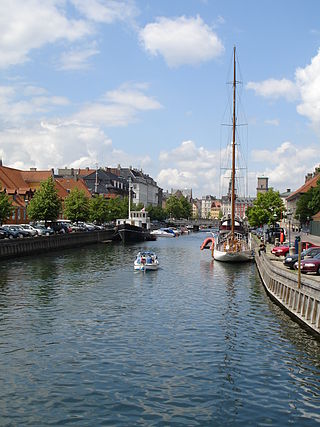
Frederiksholms Kanal is a canal in central Copenhagen, Denmark, which runs along the south-west side of Slotsholmen, together with Slotsholmskanalen separating the island from Zealand. The name also applies to the continuation of Rådhusstræde which follows the canal for most of its course, first on its south side and for the last stretch, from Prinsens Bro and to the waterfront, on both sides of the canal. Several historic buildings face the canal, ranging in size from Prince's Mansion, now housing National Museum, and Christiansborg's riding grounds to the diminutive Stable Boy's House, part of Civiletatens Materialgård, a former storage facility now used by the Royal Danish Academy of Fine Arts's School of Sculpture.

The Equestrian statue of Frederick VII in front of Christiansborg on Slotsholmen in Copenhagen, Denmark, was modelled by Herman Wilhelm Bissen and completed posthumously by his son Vilhelm Bissen in 1873. It was created to commemorate King Frederick's central role in Denmark's transition from absolute to constitutional monarchy.

The equestrian statue of Absalon on Højbro Plads in Copenhagen was unveiled in 1902 to mark the 700th anniversary of the death of Bishop Absalon, the city's legendary founder.
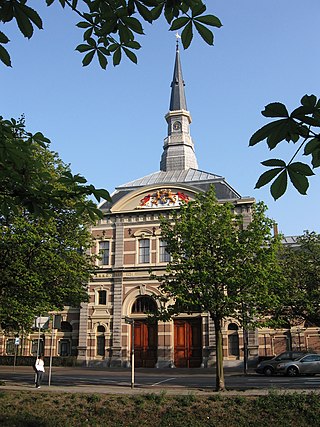
The Royal Stables is a collection of equestrian stables of the Dutch royal family, the House of Orange-Nassau. It is a Rijksmonumental building that is part of the royal palace grounds located in the city center of The Hague in the Netherlands. The Noordeinde Palace and the Palace Gardens are also part of this same palace complex. The Noordeinde Palace and its grounds are the official workplace of the Dutch King Willem-Alexander.





















